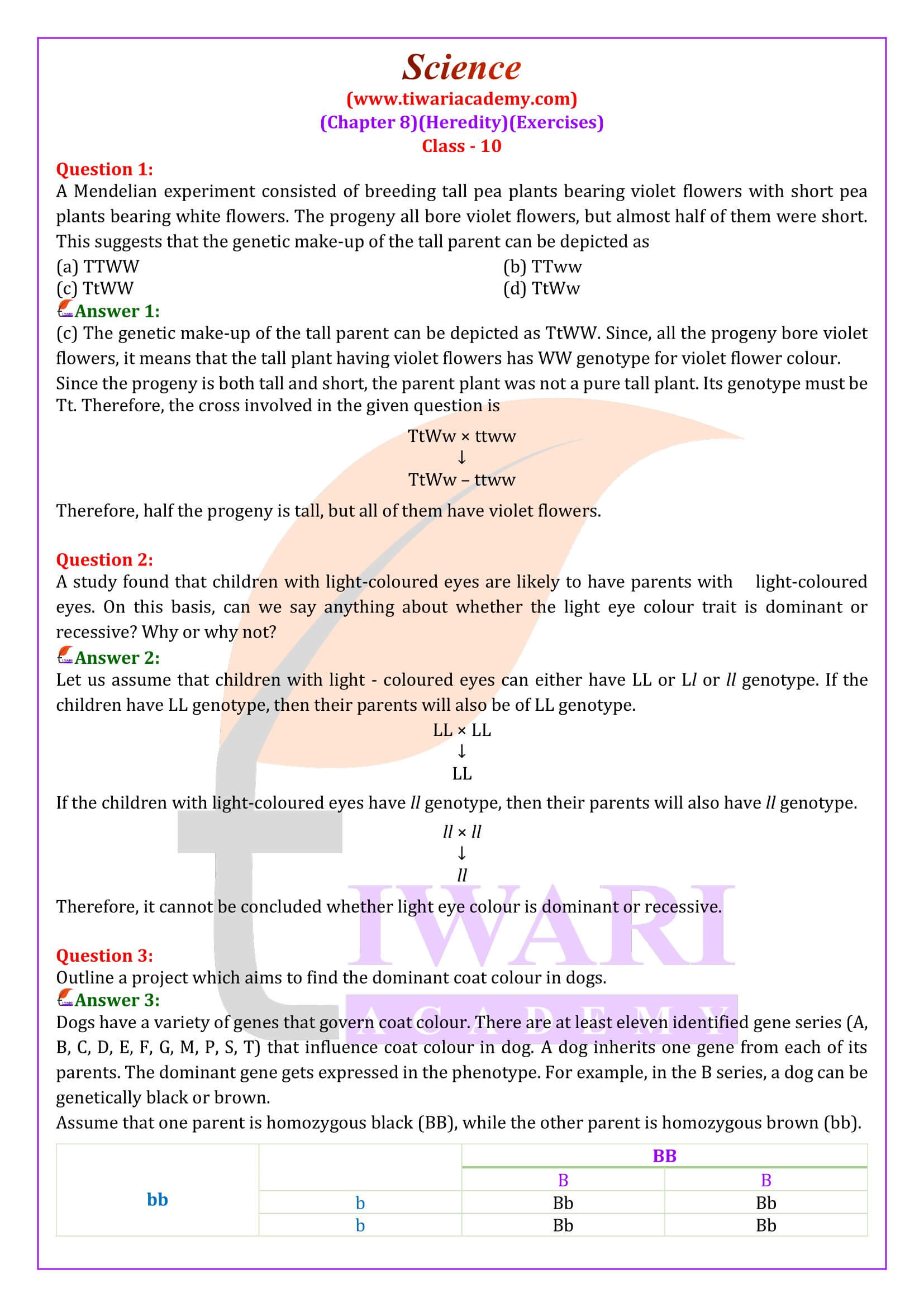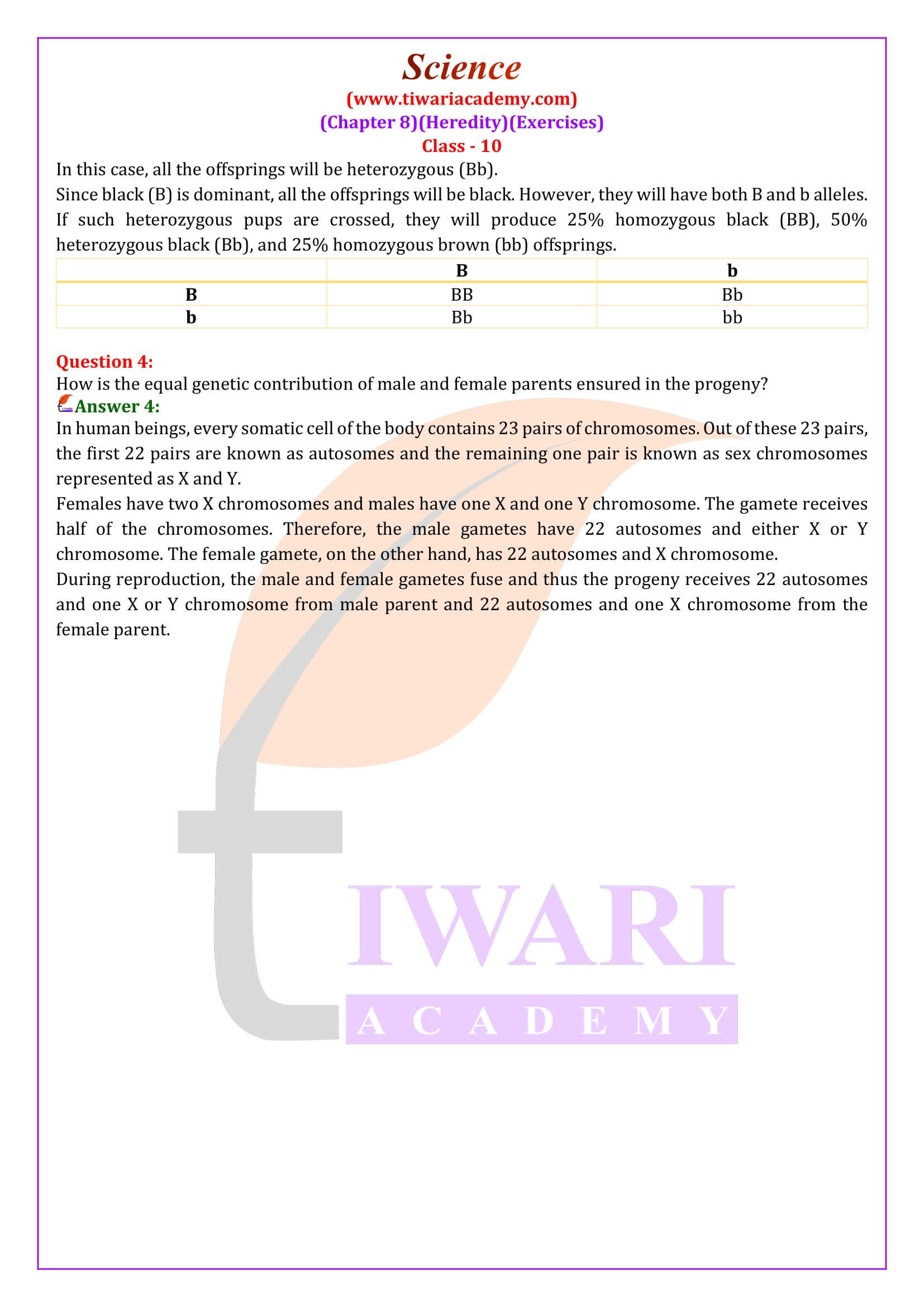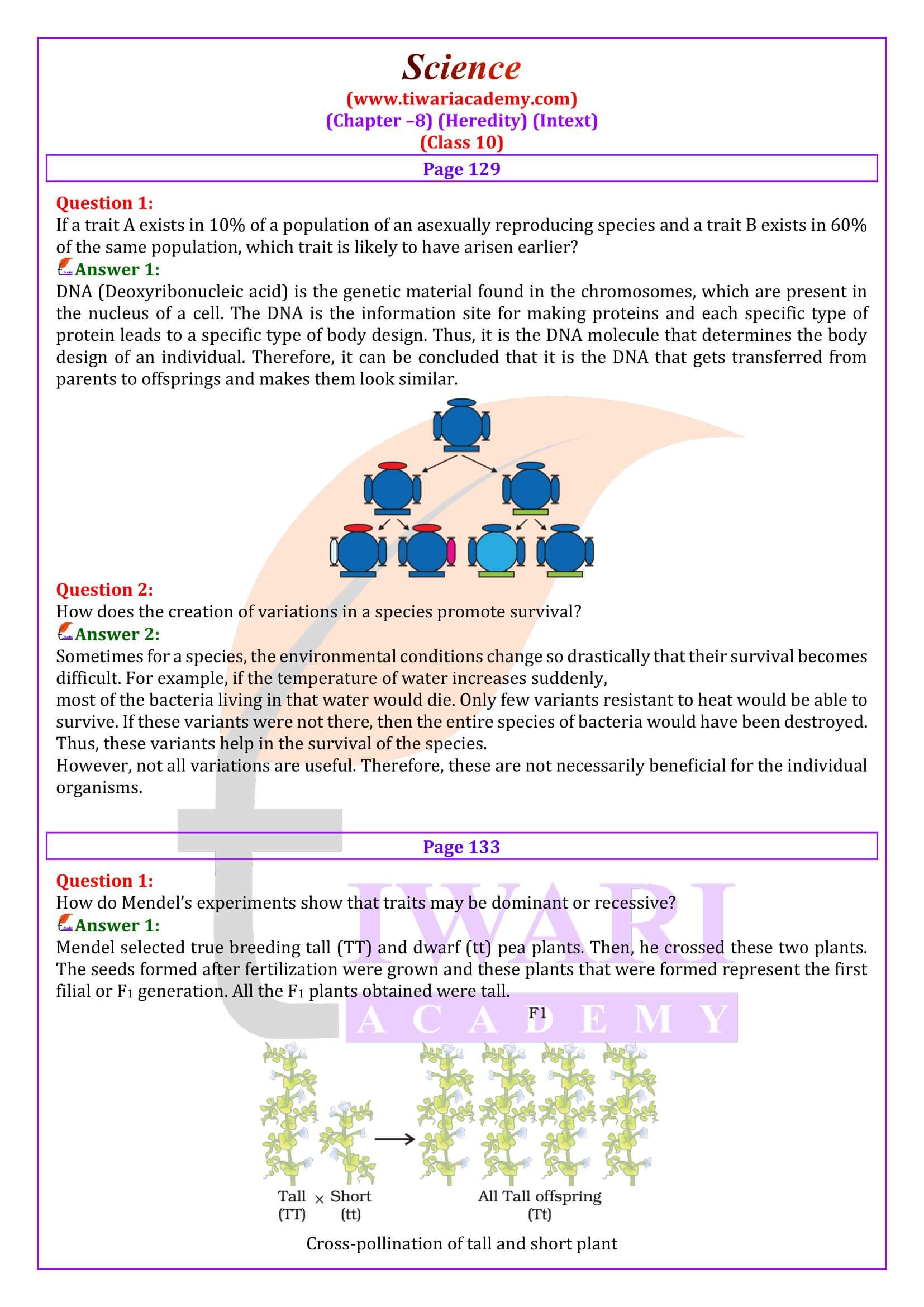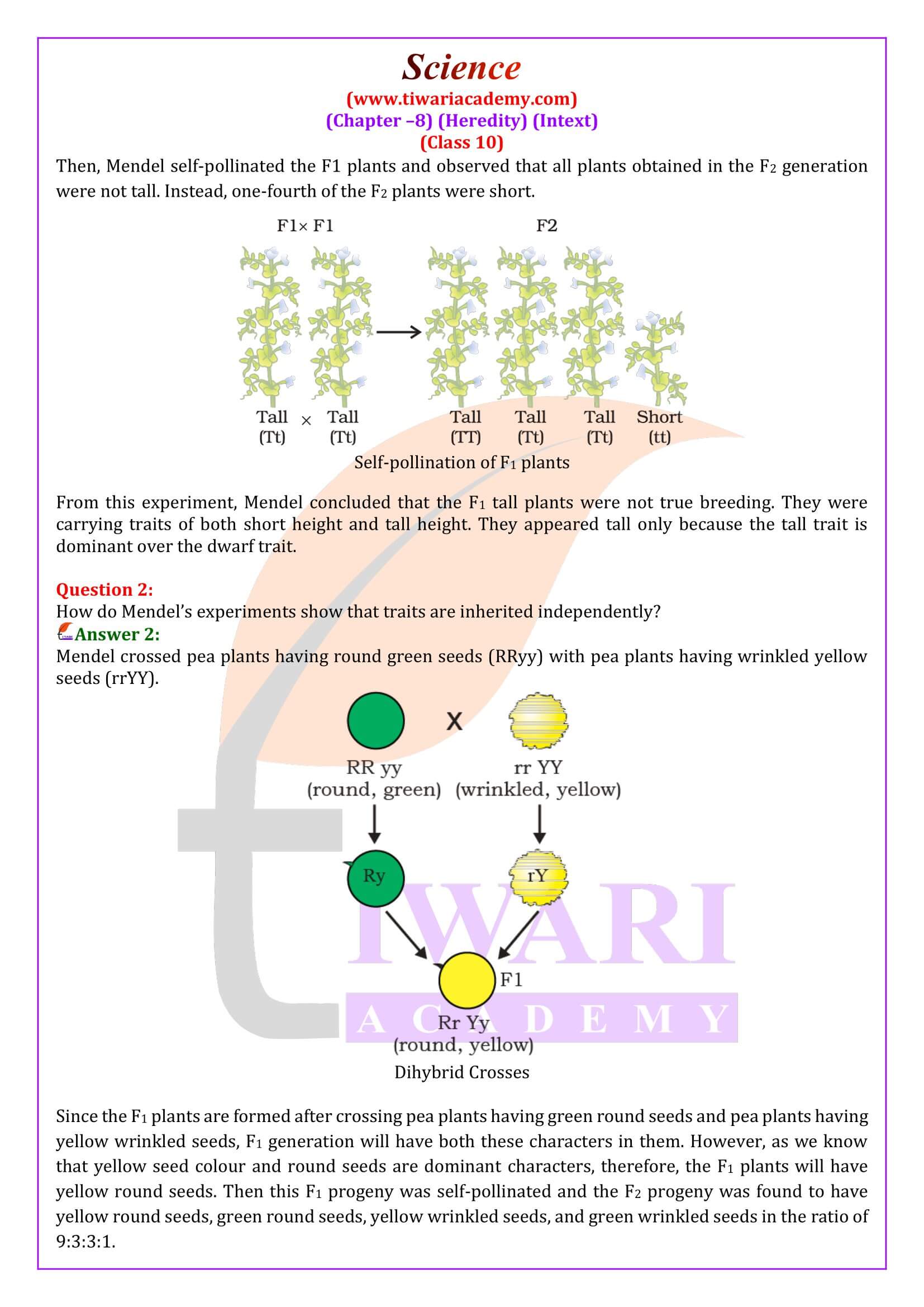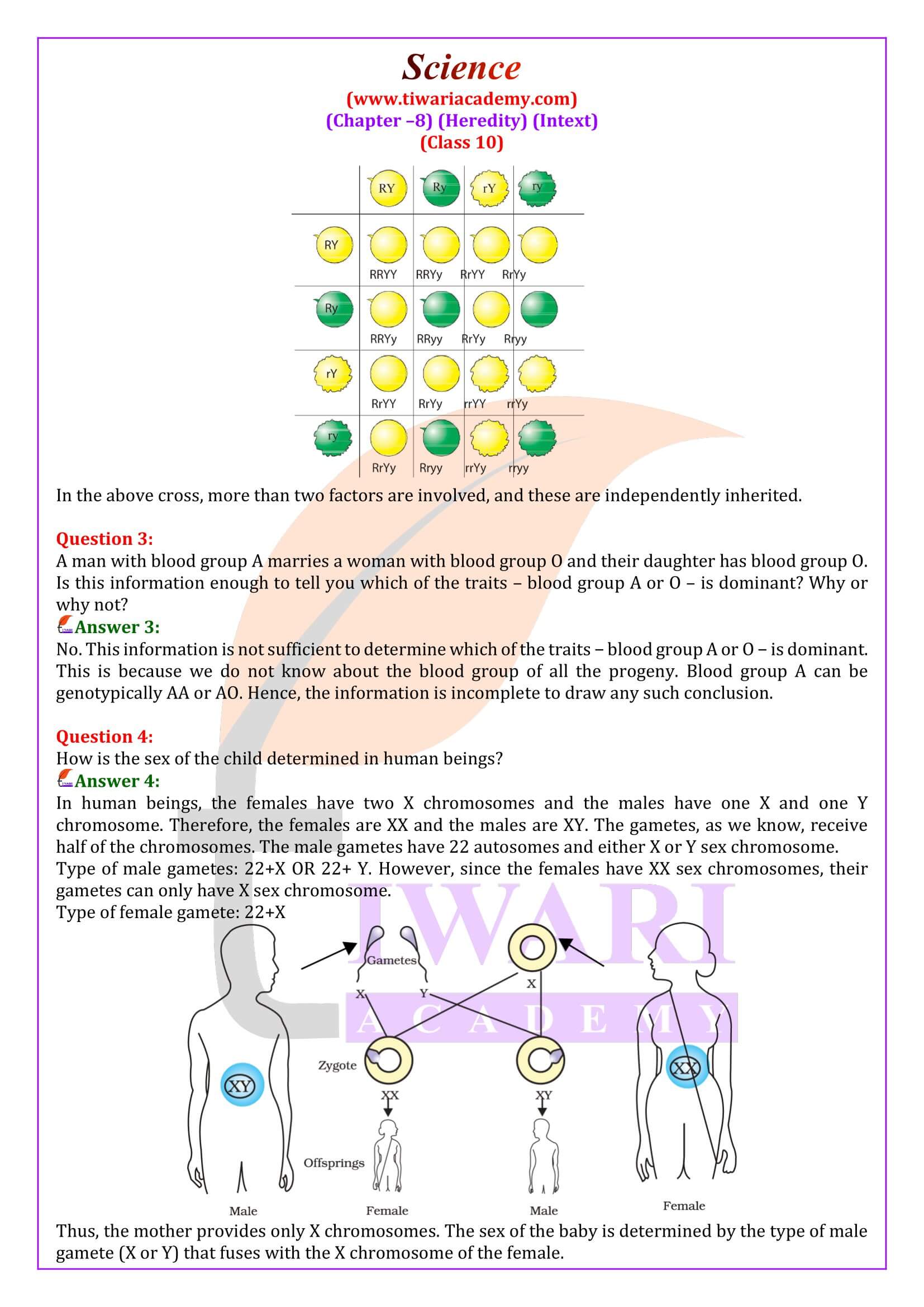Get the latest and updated NCERT Solutions for Class 10 Science Chapter 8, focusing on Heredity, for the academic session 2025-26. Available in both Hindi and English Medium, these solutions are meticulously revised to align with the new syllabus and the latest textbooks.
How to Study for Class 10 Science
Class 10 Science Chapter 8 Solutions
Class 10 Science Chapter 8 Exercises Solutions
Class 10 Science Chapter 8 Intext Exercises
Class 10 Science Chapter 8 MCQ
Class 10 Science Chapter 8 in Hindi Medium
Class 10 Science Book Download in PDF
Class 10 Science Chapter 8 Board Questions
Class 10 Science Chapter 8 Extra Questions
NCERT Solutions for Class 10 Science Chapter 8: Heredity – Updated for 2025-26 Session
Get comprehensive answers and detailed explanations for all questions in Chapter 8 of Class 10 Science, ensuring a thorough understanding in line with the current educational trends. Perfect for students and educators seeking up-to-date resources for the 2025-26 academic year.
Class 10 Science Chapter 8 Questions in Detail
- Class 10 Science Chapter 8 Important Questions
- Class 10 Science Chapter 8 Board Questions
- Class 10 Science Chapter 8 MCQ
- If a trait A exists in 10% of a population of an asexually reproducing species and a trait B exists in 60% of the same population, which trait is likely to have arisen earlier?
- How does the creation of variations in a species promote survival?
- How do Mendel’s experiments show that traits may be dominant or recessive?
- How do Mendel’s experiments show that traits are inherited independently?
- A man with blood group A marries a woman with blood group O and their daughter has blood group O. Is this information enough to tell you which of the traits – blood group A or O – is dominant? Why or why not?
- How is the sex of the child determined in human beings?
- A study found that children with light-coloured eyes are likely to have parents with light-coloured eyes. On this basis, can we say anything about whether the light eye colour trait is dominant or recessive? Why or why not?
- Outline a project which aims to find the dominant coat colour in dogs.
- How is the equal genetic contribution of male and female parents ensured in the progeny?
| Class: 10 | Science |
| Chapter 8: | Heredity |
| Content: | Exercise and Intext Answers |
| Content Type: | Text, PDF and Videos |
| Session: | CBSE 2025-26 |
| Medium: | English and Hindi Medium |
Class 10 Science Chapter 8 Answers in Hindi and English Medium
Class 10 Science Chapter 8 Main Points
Variation and Evolution: The Class 10 Science Chapter 8 discusses how variations in species, such as bacteria’s ability to withstand heat, play a crucial role in evolutionary processes. It emphasizes the importance of environmental factors in selecting variants, which forms the basis for evolution.
Heredity and Inherited Traits: The Class 10 Science Chapter 8 delves into the rules of heredity, explaining how traits and characteristics are inherited. It highlights the similarities and differences observed in offspring, using human features like earlobes as an example to illustrate inherited traits.
Mendelian Genetics: The 10th Science Chapter 8 discusses Mendel’s experiments and the concepts of dominant and recessive traits. It explains how traits are inherited independently and how sexual reproduction leads to new combinations of traits. The text also touches upon how the sex of offspring is determined in humans, mentioning the role of X and Y chromosomes.
Genetic Makeup and Expression: The Grade 10 Science Chapter 8 explores how genetic makeup influences traits like plant height, linking it to the efficiency of enzymes and hormone production. It also explains the concept of each parent contributing one gene set to the offspring, ensuring equal genetic contribution from both parents.
Independent Inheritance of Traits: This chapter describes experiments showing the independent inheritance of traits, such as seed shape and color in pea plants. It explains how new trait combinations can arise in offspring.
Variation in Asexual and Sexual Reproduction: The 10th Science Chapter 8 heredity compares the creation of diversity in asexual and sexual reproduction, noting that sexual reproduction generates greater diversity due to the recombination of genes.
Environmental Influence on Sex Determination: It also mentions how in some species, environmental factors like temperature can determine the sex of the offspring.
The chapter 8 of 10th science provides a detailed overview of heredity, the mechanisms of genetic inheritance, and the role of these processes in evolution and species diversity.
The NCERT Class 10 Science Chapter 8 Heredity explores the concepts of heredity, genetics, and evolution. The evolution part is not in the syllabus now, so students have to focus on heredity section only. Here are the main topics covered in this chapter. Inheritance from the previous generation provides both a common basic body design and subtle changes in it, for the next generation. Explanation of variations within a species. How variations arise and contribute to diversity.
We know that the role of genes in heredity. Mendel’s experiments on inheritance. How traits or characteristics are inherited from parents. The concept of alleles and their role in determining traits. Homozygous and heterozygous individuals. Explanation of sex determination in humans. Understanding sex-linked traits and their inheritance.
Schedule or timetable to allocate specific time slots for each chapter of 10th science. Gather all the necessary study materials, including your textbook, notes, and any reference books or resources if needed. Familiarize yourself with the topics and subtopics covered in Chapter 8 of 10th Science by going through the chapter’s table of contents. Pay close attention to the text, diagrams, and examples provided in the textbook. Try to understand the main concepts and their relevance.
While reading, take concise notes. Jot down key concepts, definitions, formulas, and important examples. Create a summary of the chapter in your own words. This will help in quick revision. Utilize diagrams, charts, and tables provided in the NCERT textbook. These visual aids can help you understand complex concepts more easily. After reading the chapter, attempt the in-text questions and exercises provided in the NCERT textbook. Solve additional practice questions from other sources, such as previous year’s question papers and reference books.
If you encounter any doubts or difficulties while studying, don’t hesitate to seek help from your teacher, classmates, or online resources. Make sure you have a clear understanding of fundamental concepts such as genetics, heredity, evolution, and natural selection. Use real-life examples to relate to the concepts and make them easier to remember. Summarize important concepts and keywords on flashcards or create mind maps to visually organize information. Use these as quick revision tools.
Regularly revise the chapter to reinforce your understanding. Use your notes, flashcards, and summaries for quick revision sessions. Solve previous year’s question papers to get a sense of the exam pattern and types of questions that may appear. Practice time management during your preparation and during the exam itself. Stay Positive and Confident: Believe in your abilities and stay positive.
Take mock tests under exam conditions to assess your preparation level and identify areas that need improvement.
After taking mock tests or receiving feedback, review your performance and make necessary adjustments to your study plan. Remember that consistency and regular practice are key to mastering any subject. With dedication and a well-structured study plan, you can excel in your NCERT Class 10 Science Chapter 8.
Tiwari Academy is a valuable resource that provides supplementary materials and solutions to help students prepare for their NCERT Class 10 Science Chapter 8 (Heredity). Here’s how you can use Tiwari Academy effectively for your preparation. Visit the Tiwari Academy website to access the materials related to NCERT 10th Science Chapter 8. Navigate to the specific section for Class 10 Science to find resources related to Heredity. Tiwari Academy provides detailed solutions to the exercises and questions found in the NCERT textbook. Use these solutions to cross-check your answers and understand the correct way to solve problems.
NCERT Solutions for Class 10 Science Chapter 8
NCERT Solutions apps are based on latest NCERT Books for offline use. UP Board Students are also using NCERT Textbooks for their final board exams. Download here the UP Board Solutions for Class 10 Science Chapter 8 in Hindi Medium free of cost. Class X Science chapter 9 intext Questions given on Page 143 or Page 147 or Page 150 or Page 151 or Page 156 or Page 158 or Exercises in Hindi and English Medium free to use.
Tiwari Academy offer additional practice questions and exercises that go beyond what’s provided in the NCERT textbook. These extra questions can help you strengthen your understanding of the chapter. Tiwari Academy provide comprehensive study notes and materials that simplify complex concepts. Read through these materials to gain a better grasp of the chapter’s content. Some educational websites, like Tiwari Academy, offer video tutorials on various topics. Watching these videos can be a helpful way to visualize and understand challenging concepts.
Download NCERT Solutions in English or Hindi Medium Solution PDF format to free updated for new academic session. Question answers of Exercise and Intext are described properly with suitable example and images for Class 10 Science Chapter 8. Important Questions and Extra Questions with answers related to Chapter 8 are also available on Tiwari Academy website.
Tiwari Academy has discussion forums or boards, consider joining them to connect with other students and seek clarification on doubts. Engaging in discussions can help you learn from your peers and gain different perspectives on the subject matter. Tiwari Academy offer mock tests and sample question papers for Class 10 Science. Take these tests under timed conditions to practice answering questions in an exam-like environment. Regularly assess your progress by attempting quizzes and tests available on Tiwari Academy.
While Tiwari Academy’s resources are valuable, remember that the NCERT textbook should be your primary study material. Use Tiwari Academy’s materials as supplementary resources to enhance your understanding. Plan your study schedule efficiently, allocating specific time for Chapter 8 and other subjects. Stick to your schedule to ensure you cover all the topics effectively. If you encounter any difficulties or have questions, don’t hesitate to reach out to your teachers or peers for assistance.
10th Science Chapter 8 Answers in English & Hindi Medium
Class 10 Science Chapter 8 Extra Question Answers
How is the equal genetic contribution of male and female parents ensured in the progeny?
Genetic material in most organisms is present in pair of chromosomes. Gametes in sexually reproducing organisms are formed by the process of meiosis (a type of cell division occurring mainly in reproductive cells for the formation of gametes) during which half of the genetic material goes into each gamete. When the gametes from male and female parents fuse with each other during sexual reproduction, the normal complement is restored. Half of the genetic material comes from female and half from the male. Thus, process of meiosis is necessary to ensure equal genetic contribution of male and female parents through gametes.
Differentiate between Homologous Organs and Analogous Organs.
Homologous organs
1. Organs with similar basic plan of origin but different in function.
2. Fundamental plan of structure is similar e.g., fore-limb of man, horse and whale.
Analogous organs
1. Organs with similar function but different in origin.
2. Fundamental plan of structure is different e.g., wings of butterfly and bat.
What are fossils? State their importance in the study of evolution with the help of a suitable example.
Fossil: A fossil is the record of an organism that lived in the geologic past. Remains, impressions, cast , mould and traces of organisms of past have been preserved in the earth’s crust as fossils. Fossils help us to build up broad historical sequence of biological evolution. For example, the study of fossils of Equidae (horse) family provides reliable records of evolution. The dawn horse-five-toed Echippus, gave rise to Mesohippus which in turn developed into several lines of evolution. The modern Equus (one-toed horse) evolved from Pliohippus.
What is organic evolution?
Evolution can be defined as the changes in the genetic composition of a population with the passage of each generation. Evolution can be defined as the gradual unfolding of the organism from pre-existing organism through change since the beginning of life. The origin of life is very much associated with evolution. Evolution or organic evolution is the study of how complex organisms of today evolved (formed) from the simpler forms of the past.
How are fossils formed? State two methods of determining the age of fossils.
Fossil: Remains, impression, casts or traces of organisms of past geologic ages have been preserved in earth’s crust called fossils.
Determining age of a fossil: There are two methods:
(i) This is relative, the fossils we find closer to the surface are more recent than the fossils we find in deeper layers of earth’s crust.
(ii) The second way of dating fossils is by the ratios of different isotopes of same element in the fossil material.
10th Science Chapter 8 Heredity and Evolution Intext questions and exercises question answers are given below in English and Hindi Medium updated for academic session 2025-26. All the answers are prepared from the latest NCERT Textbooks for Class 10 Science session 2025-26. If you have any doubt in any subject, just join the Discussion Forum and ask your questions.
Consistency is key to success. Stay motivated and maintain a regular study routine. Remember that Tiwari Academy can be a valuable aid in your preparation. Utilize Tiwari Academy’s resources effectively to enhance your understanding and practice for Chapter 8 and other chapters in NCERT Class 10 Science.
NCERT Class 10 Chapter 8 Heredity is an important chapter from the perspective of board exams for several reasons. Chapters in the NCERT syllabus are designed to carry weightage in board exams. Chapter 8, like other chapters, contributes to your overall score in the science subject. The concepts discussed in this chapter are fundamental to biology and genetics. They form the basis for understanding various biological processes, which are essential components of the science curriculum.
The concepts introduced in chapter 8 are building blocks for more advanced biology topics you’ll encounter in 11th, 12th or even higher education. A strong foundation in genetics is crucial for future studies in biology. Heredity is not limited to biology alone. They have implications in fields like anthropology, genetics, medicine, and environmental science. A good understanding of this chapter can be valuable beyond the board exams.
10th Science Chapter 8 Questions for Practice
Question:
Define the following:
(a) Analogous Organs
(b) Evolution
(c) Genetic Drift
Answer:
(a) Analogous: Organs which look similar because they have common use but differ in their structure and components are called analogous organs
(b) Evolution: The gradual unfolding of events by which new organisms evolved from pre-existing organisms through changes since the beginning of life, is said to be evolution.
(c) Genetic Drift: The random change in gene frequency and gene number by chance only, irrespective of its being advantageous or not in a population is called genetic drift. The effect of genetic drift is very small in a large if population is small.
The chapter 8 of 10th science also involves logical reasoning and problem-solving skills. It requires students to understand genetic patterns, predict outcomes, and analyze evolutionary processes, which are skills that can be applied in various contexts. Chapter 8 generally contains a mix of theoretical concepts and numerical problems. Students who have a good grasp of the subject matter can score well in both the theory and practical aspects of the chapter.
Questions from Board Papers
Question 1:
Difference between Inherited and Acquired traits.
Answer 1:
Inherited Traits
1. The traits which are inherited by the parents (father and mother) by the off springs (progeny) are called inherited traits.
2. These traits cannot be acquired in the life time but are inherited from parent to the progeny.
3. These traits are due to genetic make-up of the progeny.
Acquired Characters
1. The traits which an individual does not inherit from its parent.
2. These traits are acquired by the individuals due to life time experiences. They are not transmitted
3. These traits are not inherited over generations. Because these traits or experiences are not incorporated in the germ cells (genome or DNA make up) of the individual.
Important Questions on 10th Science Chapter 8
How are the areas of study − evolution and classification − interlinked?
Classification involves grouping of organism into a formal system based on similarities in internal and external structure or evolutionary history. Two species are more closely related if they have more characteristics in common. And if two species are more closely related, then it means they have a more recent ancestor. For example, in a family, a brother and sister are closely related and they have a recent common ancestor i.e., their parents. A brother and his cousin are also related but less than the sister and her brother. This is because the brother and his cousin have a common ancestor i.e., their grandparents in the second generation whereas the parents were from the first generation. With subsequent generations, the variations make organisms more different than their ancestors. This discussion clearly proves that we classify organisms according to their resemblance which is similar to creating an evolutionary tree.
Explain how sexual reproduction gives rise to more viable variations than asexual reproduction. How does this affect the evolution of those organisms that reproduce sexually?
In sexual reproduction, two individuals having different variations combine their DNA to give rise to a new individual. Therefore, sexual reproduction allows more variations, whereas in asexual reproduction, chance variations can only occur when the copying of DNA is not accurate. Additionally, asexual reproduction allows very less variations because if there are more variations, then the resultant DNA will not be able to survive inside the inherited cellular apparatus. However, in sexual reproduction, more variations are allowed and the resultant DNA is also able to survive, thus making the variations viable. Variation and Evolution: Variants help the species to survive in all the conditions. Environmental conditions such as heat, light, pests, and food availability can change suddenly at only one place. At that time, only those variants resistant to these conditions would be able to survive. This will slowly lead to the evolution of a better adapted species. Thus, variation helps in the evolution of sexually reproducing organisms.
How is the equal genetic contribution of male and female parents ensured in the progeny?
In human beings, every somatic cell of the body contains 23 pairs of chromosomes. Out of these 23 pairs, the first 22 pairs are known as autosomes and the remaining one pair is known as sex chromosomes represented as X and Y. Females have two X chromosomes and males have one X and one Y chromosome. The gamete receives half of the chromosomes. Therefore, the male gametes have 22 autosomes and either X or Y chromosome. The female gamete, on the other hand, has 22 autosomes and X chromosome. During reproduction, the male and female gametes fuse and thus the progeny receives 22 autosomes and one X or Y chromosome from male parent and 22 autosomes and one X chromosome from the female parent.
Only variations that confer an advantage to an individual organism will survive in a population. Do you agree with this statement? Why or why not?
In species, variations that offer survival advantages are naturally selected. Individuals adjust to their environments with the help of these selected variations and consequently these variations are passed on to their progeny. Evolution of organisms occurs as a result of this natural selection. However, there can be some other variations, which do not offer any survival advantage and arise only accidentally. Such variations in small populations can change the frequency of some genes even if they are not important for survival. This accidental change in the frequency of genes in small populations is referred to as genetic drift. Thus, genetic drift provides diversity (variations) without any survival advantage.
How does the creation of variations in a species promote survival?
Sometimes for a species, the environmental conditions change so drastically that their survival becomes difficult. For example, if the temperature of water increases suddenly, most of the bacteria living in that water would die. Only few variants resistant to heat would be able to survive. If these variants were not there, then the entire species of bacteria would have been destroyed. Thus, these variants help in the survival of the species. However, not all variations are useful. Therefore, these are not necessarily beneficial for the individual organisms.
A man with blood group A marries a woman with blood group O and their daughter has blood group O. Is this information enough to tell you which of the traits − blood group A or O − is dominant? Why or why not?
No. This information is not sufficient to determine which of the traits − blood group A or O − is dominant. This is because we do not know about the blood group of all the progeny. Blood group A can be genotypically AA or AO. Hence, the information is incomplete to draw any such conclusion.
What are the different ways in which individuals with a particular trait may increase in a population?
Individuals with a particular trait may increase in a population as a result of the following: (i) Natural selection: When that trait offers some survival advantage. (ii) Genetic drift: When some genes governing that trait become common in a population. (iii) When that trait gets acquired during the individual’s lifetime.
Why are traits acquired during the life-time of an individual not inherited?
This happens because an acquired trait involves change in non-reproductive tissues (somatic cells) which cannot be passed on to germ cells or the progeny. Therefore, these traits cannot be inherited.
Why are the small numbers of surviving tigers a cause of worry from the point of view of genetics?
Small numbers of tigers means that fewer variations in terms of genes are available. This means that when these tigers reproduce, there are less chances of producing progeny with some useful variations. Hence, it is a cause of worry from the point of view of genetics.
What factors could lead to the rise of a new species?
Natural selection, genetic drift and acquisition of traits during the life time of an individual can give rise to new species.
Will geographical isolation be a major factor in the speciation of a self-pollinating plant species? Why or why not?
Geographical isolation can prevent the transfer of pollens among different plants. However, since the plants are self-pollinating, which means that the pollens are transferred from the anther of one flower to the stigma of the same flower or of another flower of the same plant, geographical isolation cannot prevent speciation in this case.
Will geographical isolation be a major factor in the speciation of an organism that reproduces asexually? Why or why not?
Geographical isolation prevents gene flow between populations of a species whereas asexual reproduction generally involves only one individual. In an asexually reproducing organism, variations can occur only when the copying of DNA is not accurate. Therefore, geographical isolation cannot prevent the formation of new species in an asexually reproducing organism.
What are fossils? What do they tell us about the process of evolution?
Fossils are the remains of organisms that once existed on earth. They represent the ancestors of plants and animals that are alive today. They provide evidences of evolution by revealing the characteristics of the past organism and the changes that have occurred in these organisms to give rise to the present organisms.
Why are human beings who look so different from each other in terms of size, colour and looks said to belong to the same species?
A species is a group of organisms that are capable of interbreeding to produce a fertile offspring. Skin colour, looks, and size are all variety of features present in human beings. These features are generally environmentally controlled. Various human races are formed based on these features. However, there is no biological basis to this concept of races. Therefore, all human beings are a single species as humans of different colour, size, and looks are capable of reproduction and can produce a fertile offspring.
In evolutionary terms, can we say which among bacteria, spiders, fish and chimpanzees have a ‘better’ body design? Why or why not?
Evolution cannot always be equated with progress or better body designs. Evolution simply creates more complex body designs. However, this does not mean that the simple body designs are inefficient. In fact, bacteria having a simple body design are still the most cosmopolitan organisms found on earth. They can survive hot springs, deep sea, and even freezing environment. Therefore, bacteria, spiders, fish, and chimpanzees are all different branches of evolution.
Question 2:
Experiences of an individual during its lifetime cannot be passed on to its progeny and cannot direct evolution. Justify this statement giving an example.
Answer 2:
Experiences of an individual during its life time are in the somatic cells of the body. That is, in non-reproductive tissues that cannot be passed to the next generation. Thus, they cannot contribute directly in evolution.
For inheritance of traits over generations and involvement in direct evolution, they must be passed to the DNA of the germ cells (reproductive tissues). The characteristics of DNA are passed to the progeny and also can play direct role in evolution.
The chapter 8 of 10th science covers topics related to heredity, and inheritance patterns, through natural selection. Understanding these concepts helps in developing a holistic understanding of life sciences. In conclusion, NCERT Class 10 Chapter 8, Heredity, is indeed important for board exams. It not only contributes to your overall science score but also lays the foundation for more advanced biology studies. It’s advisable to dedicate sufficient time and effort to understanding and mastering the concepts in this chapter to perform well in your exams and build a strong foundation for future studies.
Which questions of chapter 8 of class 10th Science are significant?
There are 29 questions (17 questions in between the chapter 8 and 12 questions in back exercise of chapter 8) in chapter 8 of class 10th Science. Significant questions of chapter 8 are questions 1, 2 (page number 143), questions 1, 2, 3, 4 (page number 147), questions 1, 2 (page number 150), question 1 (page number 151), questions 1, 3 (page number 156), questions 1, 2 (page number 158), and questions 1, 4, 6, 9, 10, 11 of back exercise.
In which terminal exam Chapter 8 of class 10th Science is being taken?
Chapter 8 of class 10th Science is a biology chapter and not a chemistry chapter. This chapter comes in the term 2 examinations. This chapter contains very knowledgeable topics. Students should once read this chapter on their own also.
Is chapter 8 of 10th Science NCERT is Difficult to Understand?
Most of the students find chapter 8 of 10th standard Science hard. Students face problems in understanding the meaning of words mention in chapter 8. Students also face problems while learning answers to questions. However, the difficulty level of any chapter varies from person to person. So, the difficulty level of this chapter depends on students also. According to some students, chapter 8 is complicated, and according to some students, chapter 8 is easy.
Is chapter 8 of class 10th Science lengthy or short?
Chapter 8 of class 10th Science is not very lengthy and not very short. If students give 1-2 hours per day to this chapter then, they require ten days to complete chapter 8 of class 10th Science. This time is an approximate time and can vary.
